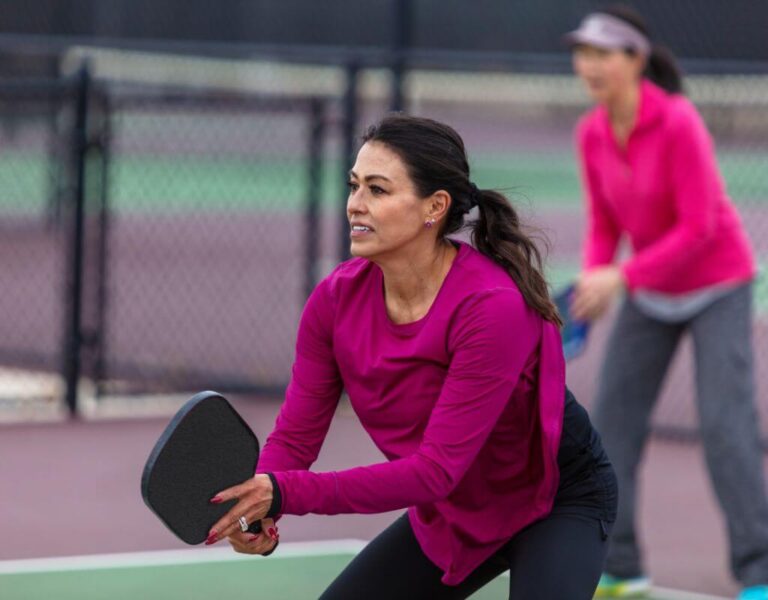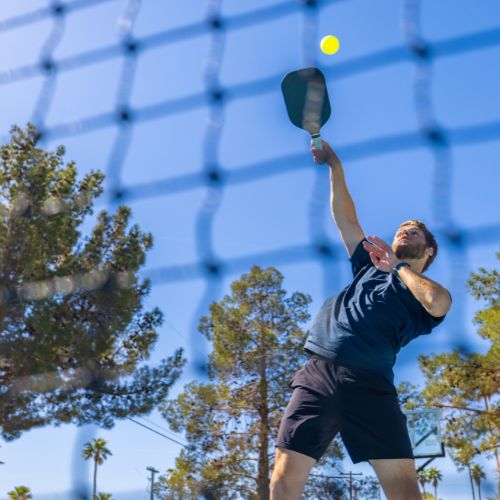In pickleball, success comes from having the perfect blend of skill, strategy, and equipment. And pickleball paddle weight is one of the key factors that affect a player’s performance—and even their well-being.
In this article, we discuss the impact pickleball paddle weight guide has on players, with a focus on guiding players toward informed decisions. We will explore the best paddle weight options, techniques for customizing paddle weight, and how to choose the correct weight to alleviate the discomfort of tennis elbow.
Let’s get right to it.
Pickleball Paddle Weight Guide: Everything You Need to Know
Pickleball paddle weight guide isn’t just a matter of personal preference. It significantly influences your gameplay.
The weight of your paddle directly impacts your ability to:
- Generate power
- Exercise control over your shots
It even affects the degree of fatigue you experience during long matches. Trust us on this: After playing for a long time, you will feel the pressure on your joints.
Significance of Paddle Weight in Power, Control, and Player Fatigue
Heavier pickleball paddles have more mass. This increase in weight allows players to deliver more powerful shots with increased momentum. Heavier paddles also tend to have a bigger face, which means a larger sweet spot to be able to land those perfect shots.
But, the heavier your paddle is, the easier and faster you will tire out after using it, especially if you’re new to pickleball. Just imagine doing the same action, hitting the same shots repeatedly for a whole hour. The action itself will tire you out. Add the increased weight of a heavier paddle into the mix and you’ll be lucky not to injure yourself on the first round.
On the other hand, lighter paddles offer better maneuverability. You’ll be more free to twist and turn your joints without worrying about hurting your elbows and shoulders. Your reactions will be quicker and your shots will have more control.
To sum up, heavier paddles provide more power, but lighter paddles are easier to control.
Pickleball Paddle Weight Guide
Pickleball paddles usually come in three weight ranges: lighter, mid-weight, and heavier paddles. Here’s how they differ.
- Lighter paddles
Lighter paddles often range from 6.5 to 7.5 ounces in weight. They are favored for their agility and ease of use, making them ideal for players seeking precision and finesse in their shots.
- Mid-weight paddles
Mid-weight paddles weigh between 7.6 to 8.5 ounces. They strike a good balance between power and control and cater to a broad range of playing styles.
- Heavier paddles
Weighing 8.6 ounces and above, heavier paddles deliver substantial power behind shots, but they also require more effort and strength to handle effectively.
Paddle Weight: Choosing The Right One For You
Factors Affecting Paddle Weight Preference
How you choose your pickleball paddle’s weight will depend on personal preferences and practical considerations. Several factors come into play, but the choice ultimately boils down to playing style and objectives.
Here are the key factors that may influence your pickleball paddle weight guide preference.
- Playing Style and Techniques
Aggressive players who like to deliver powerful smashes and drives will do well with a heavier pickleball paddle. On the other hand, players who train for control and finesse should get lighter paddles that can deliver quick reactions and precise shot placement.
- Physical Attributes and Fitness Level
Fitness level, especially physical strength, and flexibility, plays a role in determining how much weight a player can handle during extended matches. Someone who hits the gym often will be able to wield a heavier paddle better compared to someone who sits around all day.
- History of Injuries and Comfort
Players with a history of arm or elbow injuries should go for lighter paddles to reduce strain. Your paddle should be comfortable to use and play with. If anything starts to hurt while playing, take appropriate rests and try switching to a different paddle.
- Adaptation and Experimentation
Players often experiment with various paddle weights until they find what feels most natural and effective to them. As you keep playing and practicing, your body will eventually adapt to the weight of your pickleball paddle. You will be able to refine your technique and discover what works best for you.
By combining personal preference, physical ability, playing style, and comfort, players can make informed decisions about which pickleball paddle weight to go for that can enhance their performance and enjoyment on the pickleball court.
Trends and Shifts in Paddle Weight Preferences
As the sport of pickleball continues to evolve, so do the trends and preferences surrounding paddle weight. Professional players, competitive enthusiasts, and players with specific concerns like tennis elbow contribute to the dynamic shifts in what players look for when it comes to paddle weight.
These are the current trends that affect pickleball paddle weight.
- Customization and Tailored Solutions
There is a trend toward customization because players are looking for paddles that align perfectly with their playing styles and strengths. This includes custom weights, strategic placements, and personalized modifications. Combined, they allow players to fine-tune their equipment for optimal performance.
- Emphasis on Versatility
A lot of players have started to use mid-weight paddles, indicating a desire for versatility. Players want paddles that balance power and control, accommodating various shots and strategies.
- Technological Advancements
Advancements in technology mean we can now have paddles that deliver exceptional performance without the added weight. Composite materials, unique core constructions, and advanced manufacturing techniques have greatly affected paddle weight distribution, which is influencing player preferences.
- Response to Physical Demands
People have become more aware of the impact of paddle weight on injuries like tennis elbow. This has led to a surge in players choosing lighter pickleball paddles to minimize strain.
- Influences from Professional Players
The weight preferences of professional players often inspire trends among recreational players. Some professionals achieve success with specific paddle weights, so enthusiasts want to experiment with those preferences to improve their own gameplay.
- Eco-Friendly and Sustainable Materials
Some manufacturers of pickleball paddles are slowly moving towards greener options to cater to players who are environmentally conscious.
Paddle Weight Selection for Tennis Elbow Relief
Tennis elbow is an overuse injury more commonly found in tennis players. But players of other racket sports like pickleball are also at risk for developing this condition.
The repeated muscle contractions involved in swinging a racket cause the muscles on the arm to become strained, leading to pain in the outer elbow. You might have trouble gripping and lifting objects without experiencing pain.
Aside from rest, ice, and therapy, you’ll need to be careful about choosing your pickleball paddle weight if you want to get back into the game—or, even better, to prevent the injury from happening in the first place.
If you’re suffering from tennis elbow, here’s a guideline to help you:
-
Lighter Paddles for Reduced Strain
- These exert less strain on the arm and elbow during play.
- Reduced weight can alleviate the pressure on the muscles involved in swinging, lessening the risk of tennis elbow.
-
Balanced Mid-Weight Paddles for Control
- Gives you good power and control.
- The balanced weight distribution helps prevent overexertion and offers better maneuverability. You’ll have more control and less stress.
-
Personalized Adjustments Based on Strength and Style
- Assess your upper body strength and overall fitness level to make a more informed decision about the ideal weight range for your paddle.
It’s essential to prioritize your comfort and well-being when selecting a paddle weight to address tennis elbow. Experimentation is key. You can always try different weights. Just be sure to pay attention to how your arm and elbow respond during and after play. If you can, consult with a sports physiotherapist or medical professional for advice, as they can provide insights specific to your condition.
How to Add Weight to Pickleball Paddle
Being able to customize a pickleball paddle’s weight empowers players to tailor their equipment to their unique needs and preferences. Adding weight to your paddle has its advantages, like enhanced power and increased stability.
If you feel you can handle a heavier paddle, but don’t want to let go of the one you currently have, here’s a step-by-step guide on how to increase its weight.
-
Choose Suitable Weight Materials.
Consider how much weight you want to add. Lead tape is the most common option for adding weight to your paddle. It is heavy and easy to customize. You can also try silicone inserts, which are lighter than lead tape and can be inserted into the handle or other parts of your pickleball paddle to add weight.
-
Prepare Paddle Surface for Attachment.
Clean the area where you intend to attach the weight to ensure a secure bond. Make sure there is no dirt or residue.
-
Attach Weights Strategically.
Attaching the weight to your paddle’s sweet spot will allow you to fine-tune your paddle’s swing weight and power. Start by applying a small amount of weight first, then test it out. Gradually increase until it feels right in your hand.
-
Ensure Secure Attachment and Safety.
Press the weight firmly onto the paddle’s surface to ensure proper adhesion. Check the weight occasionally to ensure it remains securely attached during play.
Avoid adding too much weight as this might affect the paddle’s integrity and performance. If you want to switch from a light paddle to a heavy paddle, you’re better off buying a brand-new one.
-
Experiment and Refine.
Take your modified paddle to the court and experiment with shots to gauge the impact of the added weight on your gameplay. You should pay attention to how the paddle feels in your hand and adjust the weight placement if necessary.
Considerations Beyond Paddle Weight
Yes, your pickleball paddle weight is crucial. But there are a lot of other factors for choosing your pickleball paddle that can affect your in-game performance and prevent injuries. Below are added considerations for you to think about.
-
Grip Size and Comfort
A paddle’s grip size affects how it feels in your hand and influences your playing technique. Choose the right grip size for you, that provides optimal comfort and control.
-
Paddle Shape
A paddle’s shape and surface texture can influence your interaction with the ball. A wider face has a larger sweet spot, but a narrower face gives you a longer reach.
-
Surface Texture of Paddle Face
Here’s a table comparing a smooth pickleball paddle surface versus a textured pickleball paddle surface.
| Smooth Surface | Textured Surface |
|---|---|
|
|
|
|
|
|
|
|
|
|
Playing Technique and Style
Your playing style is important. You can be an aggressive, defensive, or strategic player. Find a paddle with the appropriate weight, grip size, and shape to maximize your strengths.
Conclusion
Paddle weight plays an important role in performance, player comfort, and in the prevention of sports-related injuries. Whatever paddle weight you choose, always consider your playing style, comfort, and fitness level.




































